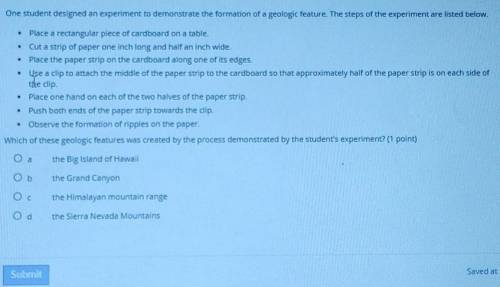
Biology, 29.04.2021 07:00 Camill0310
One student designed an experiment to demonstrate the formation of a geologic feature. The steps of the experiment are listed below. Place a rectangular piece of cardboard on a table. Cut a strip of paper one inch long and half an inch wide Place the paper strip on the cardboard along one of its edges. Use a clip to attach the middle of the paper strip to the cardboard so that approximately half of the paper strip is on each side of the dip. Place one hand on each of the two halves of the paper strip Push both ends of the paper strip towards the clip. Observe the formation of ripples on the paper. Which of these geologic features was created by the process demonstrated by the student's experiment? (1 point) the Big Island of Hawaii Ob the Grand Canyon oc the Himalayan mountain range the Sierra Nevada Mountains


Answers: 1


Another question on Biology

Biology, 22.06.2019 05:30
Why do oceanic plates tend to subduction when colliding with a continental plate
Answers: 3


Biology, 22.06.2019 11:30
Female luna moths (actias luna) attract males by emitting chemical signals that spread through the air. a male hundreds of meters away can detect these molecules and fly toward their source. the sensory organs responsible for this behavior are the comblike antennae visible in the photograph shown here. each filament of an antenna is equipped with thousands of receptor cells that detect the sex attractant. based on what you learned in this chapter, propose a hypothesis to account for the ability of the male moth to detect a specific molecule in the presence of many other molecules in the air. what predictions does your hypothesis make? design an experiment to test one of these predictions.
Answers: 1

Biology, 22.06.2019 13:20
Imagine a self-reactive t cell that has not undergone clonal deletion in the thymus (that is to say, it has escaped central tolerance). if it encounters self antigen in the absence of an infection or inflammation, what will happen to this self-reactive t cell? (select two answers) (a) the t cell undergoes clonal expansion. (b) the t cell gains effector functions. (c) the t cell undergoes apoptosis. (d) the t cell becomes activated. (e) the t cell becomes anergic.
Answers: 1
You know the right answer?
One student designed an experiment to demonstrate the formation of a geologic feature. The steps of...
Questions

Social Studies, 15.08.2020 18:01

Social Studies, 15.08.2020 18:01









English, 15.08.2020 18:01





Mathematics, 15.08.2020 18:01






